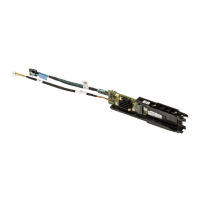Menu Item Description
Memory Operating Mode Specifies the memory operating mode. The options available are
Optimizer Mode, Advanced ECC Mode, Mirror Mode, Spare Mode,
Spare with Advanced ECC Mode, and Dell Fault Resilient Mode. By
default, the Memory Operating Mode option is set to Optimizer Mode.
NOTE: The Memory Operating Mode can have different default and
available options based on the memory configuration of your
system.
NOTE: The Dell Fault Resilient Mode establishes an area of memory
that is fault resilient. This mode can be used by an OS that supports
the feature to load critical applications or enables the OS kernel to
maximize system availability.
Node Interleaving Specifies if Non-Uniform Memory architecture (NUMA) is supported. If
this field is Enabled, memory interleaving is supported if a symmetric
memory configuration is installed. If Disabled, the system supports
NUMA (asymmetric) memory configurations. By default, Node
Interleaving
option is set to Disabled.
Snoop Mode Specifies the Snoop Mode options. Snoop Mode options available are
Home Snoop, Early Snoop, Cluster on Die. By default, the Snoop Mode
option is set to Early Snoop. The field is available only when Node
Interleaving is Disabled.
Processor Settings screen
You can use the Processor Settings screen to view the processor settings and perform specific functions
such as enabling virtualization technology, hardware prefetcher, and logical processor idling.
You can view the Processor Settings screen by clicking System Setup Main Menu → System BIOS →
Processor Settings.
Menu Item Description
Logical Processor Enables or disables the logical processors and displays the number of
logical processors. If the Logical Processor option is set to Enabled, the
BIOS displays all the logical processors. If this option is set to Disabled,
the BIOS only displays one logical processor per core. By default, the
Logical Processor option is set to Enabled.
Alternate RTID (Requestor
Transaction ID) Setting
Enables you to allocate more RTIDs to the remote socket, thereby
increasing cache performance between the sockets or easing work in
normal mode for NUMA. By default, the Alternate RTID (Requestor
Transaction ID) Setting is set to Disabled.
Virtualization Technology Enables or disables the additional hardware capabilities provided for
virtualization. By default, the Virtualization Technology option is set to
Enabled.
Address Translation Service
(ATS)
Defines the Address Translation Cache (ATC) for devices to cache the
DMA transactions. This field provides an interface to a chipset's Address
Translation and Protection Table to translate DMA addresses to host
addresses. By default, the option is set to Enabled.
Adjacent Cache Line
Prefetch
Optimizes the system for applications that require high utilization of
sequential memory access. By default, the Adjacent Cache Line Prefetch
option is set to Enabled. You can disable this option for applications that
require high utilization of random memory access.
25

